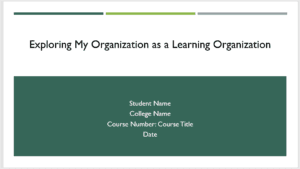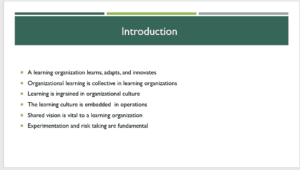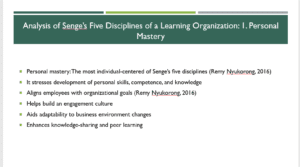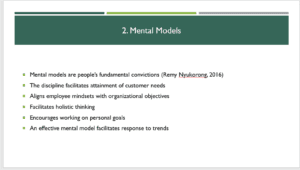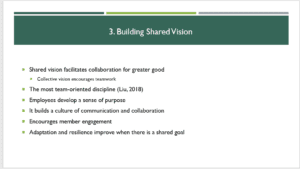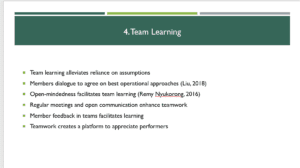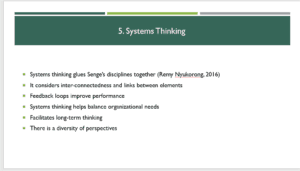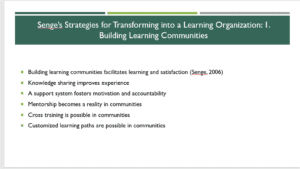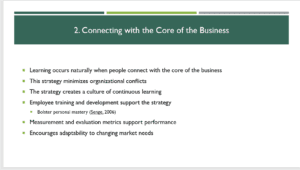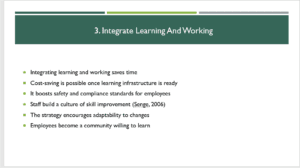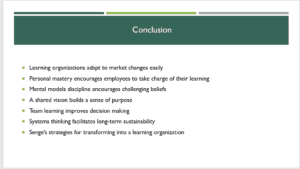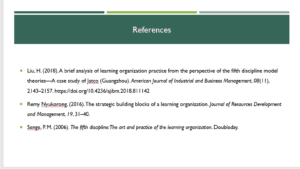Exploring My Organization as a Learning Organization
Hello, and welcome to today’s presentation, which delves into Senge’s five disciplines of a learning organization. Subsequently, the presentation highlights how my organization, Life Change Fitness, applies Senge’s five disciplines to its operations. Lastly, the final part of the project highlights three of the eight transformation strategies into a learning organization that may be applied by Life Change Fitness organization. We offer help in reliable writing assignments.
Peter Senge developed the concept of learning organization, which applies to modern organizations. The term refers to an organization willing to learn, adapt, and innovate to gain a competitive edge. An analysis of Life Change Fitness’s strengths and weaknesses qualifies it as a learning organization. One of the features that qualifies Life Change Fitness as a learning organization is the facility’s learning initiatives, which are ingrained in its organization’s culture. To ensure expert instructors are available to guide members, Life Change facilitates regular training and development for instructors. The availability of training programs equips instructors with expert skills, which have played a significant role in member retention at the facility. Another strength at Life Change Fitness that aligns with Peter Senge’s attributes of a learning organization is the embedding of a learning culture in operations. As it will be discussed at a later stage of this presentation, Life Change Fitness has availed infrastructure that facilitates on-the-job training for fitness instructors and front office staff. Further, Life Change Fitness instructors’ dedication to experimentation cannot be overstated. The instructors, in consultation with members, experiment with new training routines. However, Life Change Fitness has weaknesses, including a lack of dedication to the shared vision. Guidance is needed to help instructors and members build a solid sense of shared vision. Based on the attributes above, it is safe to say that Life Change Fitness is a learning organization.
Personal mastery, one of Senge’s five disciplines, applies to fitness centers where it helps employees and trainees achieve professional and personal objectives. It is one of the most individual-centered disciplines, focusing on personal development through learning (Remy Nyukorong, 2016). Life Change Fitness encourages employee development by facilitating learning and development programs. Employees at Life Change Fitness attend annual workshops and training programs and receive certifications to keep them updated with industry trends and changes. Also, personal mastery aligns employees with organizational goals by setting a policy that all employees set new goals regularly (Remy Nyukorong, 2016). Another component of personal mastery that encourages organizational learning is member engagement. Gym members at Life Change Fitness are permitted to participate in planning their workout plans and setting goals that suit their needs. The culture of personal mastery also creates a practice of knowledge sharing, which improves an organization’s adaptability to changes in the business environment.
Another discipline that is relevant to modern organizations, including fitness centers, is mental models. Mental models refer to people’s beliefs and assumptions that affect how they behave and respond to the world (Remy Nyukorong, 2016). The discipline helps a fitness center meet its customers’ expectations by adjusting workout plans to suit customer expectations. At Life Change Fitness Center, gym instructors meet with trainees to understand their mental models before beginning sessions. For instance, some customers are motivated by health goals, while others work out to stay fit. Besides, the mental model discipline aligns employees with organizational goals by helping them adjust their convictions. Another benefit of mental models is that they facilitate holistic thinking and keep up with market trends. Life Change Fitness Center trainers attend workshops that help them keep up with industry changes.
A shared vision in an organization encourages members to execute a collaborative effort to attain organizational goals. It is the most team-oriented discipline among Peter Senge’s five learning organization disciplines (Liu, 2018). A shared vision builds a cohesive community of organizational members who work toward attaining a collective goal. The collective vision at Life Change Fitness Center is to create a fitness culture in the community, which will go a long way to alleviate fitness and health challenges in the future (Liu, 2018). Most employees align with the vision because it attaches a sense of purpose to their work, giving them a reason to report daily. Besides, a shared vision encourages a culture of open communication and collaboration in the organization. During hard times, especially when the business is down, and subscription remittances go down, a shared vision keeps members resilient and helps them to adapt to changes.
Team learning is a culture of collective thinking and learning devoid of assumptions. Before implementing a new strategy, the team members engage in an open dialogue aimed at sharing different points of view to create the most effective strategy (Liu, 2018). Open-mindedness is vital during team learning since it enables the team to consider every view before reaching an agreeable position (Remy Nyukorong, 2016). At Life Change Fitness, weekly meetings are held to keep trainers up to date with the latest training trends. Trainers also discuss the most suitable workout plans for specific clients, whereas the front desk receptionists share experiences with different clients. Team meetings also allow the rest of the team members to appreciate the best performers, motivating them to do even better in the future.
Systems thinking refers to approaches to understanding complex systems. It glues the rest of Senge’s disciplines together by providing insights into a system-wide performance improvement approach (Remy Nyukorong, 2016). One of the benefits of systems thinking is that it helps understand the interconnectedness and interdependence between system elements (Remy Nyukorong, 2016). For instance, different elements affect the performance of Life Change Fitness Center, including subscription fees, marketing strategies, and the state of gym equipment. Our organization examines the facilities regularly to enhance customer satisfaction. Systems thinking also attaches value to feedback through feedback loops through which the center tracks member satisfaction. Systems thinking also facilitates long-term thinking and presents diverse perspectives to improve the organization.
According to Senge (2006), building learning communities will go a long way to enhance customer and employee satisfaction in any organization. In the case of the fitness center, learning communities will comprise gym goers willing to train as a group. I chose this strategy because it suits a workout setting where peer motivation is necessary. One of the benefits of this strategy is that it enhances knowledge sharing among trainees, who will share diverse experiences about workout routines and nutrition tips. Besides, the support system present in a learning community fosters a sense of accountability and motivation, whereby gym members will compete on who trains best. Eventually, all gym members will feel pressure to perform to reach their peers’ performances. Finally, customized learning paths are possible in communities. A community helps individuals understand their goals better and can then train according to their needs.
The second strategy I chose to support the transformation of Life Change Fitness into a learning organization is to connect members with the core of the business. I chose this strategy because a fitness center is more than a profit-making entity. Life Change Fitness seeks to improve the local population’s health, fitness, and exercise habits, and making profits without attaining this goal may not make sense. The strategy will minimize organizational conflicts and facilitate learning since every member understands the organization’s ultimate goal. The gym will initiate training and development programs to support the strategy. Such training programs will bolster personal mastery, which is one of Senge’s five disciplines of a learning organization (Senge, 2006). Besides, establishing and aligning with the core of the business forms the foundation of setting performance metrics that will bolster performance. Finally, sticking to the core of the business helps an organization survive when there is low business, as it attracts customers who believe in its policies.
Integrating work and learning is the third strategy to transform Life Change Fitness into a learning organization. I chose this strategy because gym instructors are busy most of the time; hence, getting time to learn new fitness trends and routines is almost impossible. The fitness center will build infrastructure to support learning while instructors conduct their normal duties. This cost-saving strategy will build a culture of skill improvement since instructors do not have to take breaks from work to facilitate learning (Senge, 2006). The organization will easily adapt to market changes since its staff are constantly informed about market trends that may affect clients’ preferences. Besides, learning at work builds a community of individuals ready to support one another through the learning process. Finally, the staff may not require more guidelines on compliance and safety since the learning process will help them understand these aspects of their work.
Given the constant changes in the business environment, only learning organizations will likely survive in such an environment. Peter Senge’s five learning organization disciplines are critical for an organization aspiring to learn and improve operations. As indicated, personal mastery, the most individual-oriented among the five disciplines, facilitates the personal development and growth of individual employees. Another is the mental models discipline that encourages organizations to understand people’s values and challenge them positively. Thirdly, a shared vision creates a sense of purpose since all organizational staff understand what the company is pursuing and are aligned with it. On the other hand, team learning improves members’ decision-making capacity and problem-solving skills. Finally, systems thinking, the most critical of the five disciplines, encourages organizational staff to understand the interconnectedness and interdependence between system elements that affect performance. The presentation also delved into three of Senge’s eight strategies for transforming an entity into a learning organization. One such strategy is to build learning communities, a trend that will encourage peer learning and knowledge exchange in an organization. Besides, connecting staff with the core of the organization’s business helps the organization generate measurable metrics to motivate staff to perform. The third strategy that suits Life Change Fitness is integrating learning and working, which will save time and the cost of training.
ORDER A PLAGIARISM-FREE PAPER HERE
We’ll write everything from scratch
Question
Overview:
This week, we have reviewed Senge’s five disciplines of a learning organization. For
this assignment, you will create a Powerpoint presentation evaluating your organization
using Senge’s disciplines.
Introduction to the Psychiatric Mental Health Nurse Practitioner
Instructions:
• First, explore whether your organization is a learning organization.
Discuss your findings, evaluating both strengths and weaknesses. If
relevant, you can use the past six weeks of analysis that you have
performed on your organization as evidence to support your judgment.
• Analyze each of the five disciplines.
In your analysis, tell your audience how your evidence (behavior of your
organization) supports your claims. You must support your position, going
beyond simply providing an example.
• Discuss the challenges that your organization would face moving to a learning
organization.
Use three of Senge’s eight strategies that would help your organization to
transform into a learning organization.
Explain why you selected these three strategies over the others.
In your analysis, discuss specifically how these strategies would help your
company.
Requirements:
• Develop a PowerPoint with a clear introduction, body, and conclusion.
• The PowerPoint should be in APA format and include the following elements:
MGT340 – Learning Organizations
Unit 7 Assignment: Is Your Organization a Learning Organization?
Copyright Post University 2021
All Rights Reserved
o A title on each slide.
Use of bullet points. Add any details to the notes section of each slide.
Graphics are optional; if you choose to use graphics, ensure that each is
relevant.

